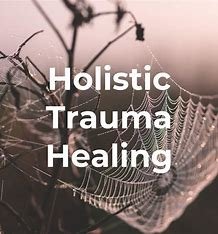Healing trauma through holistic practices involves addressing the physical, emotional, mental, and spiritual dimensions of an individual. This comprehensive approach supports resilience and recovery by fostering a deep sense of safety, connection, and empowerment.

1. Body-Based Healing Approaches
Trauma often manifests physically, so reconnecting with the body is essential.
- Somatic Experiencing: Focuses on releasing trauma stored in the body through awareness of physical sensations and gentle movement.
- Yoga: Trauma-sensitive yoga helps individuals reconnect with their bodies, regulate their nervous systems, and release stored tension.
- Breathwork: Practices like diaphragmatic breathing or alternate nostril breathing help calm the body and reduce stress.
- Massage and Bodywork: Techniques like craniosacral therapy or myofascial release can help release trauma-related tension in the body.
2. Mindfulness and Meditation
These practices help individuals remain present, reduce anxiety, and regulate emotions:
- Mindfulness Meditation: Encourages nonjudgmental awareness of thoughts and feelings, helping individuals process trauma.
- Loving-Kindness Meditation: Fosters self-compassion and reduces self-criticism, which are common in trauma survivors.
- Grounding Exercises: Techniques like focusing on physical sensations or naming objects in a room help manage flashbacks and dissociation.
3. Emotional Processing and Expression
Healing involves safely processing and expressing emotions tied to trauma:
- Therapeutic Writing: Journaling about thoughts and feelings can help organize and release emotional pain.
- Art Therapy: Drawing, painting, or creating can offer non-verbal ways to explore and process trauma.
- Music and Sound Therapy: Listening to or creating music can soothe the nervous system and facilitate emotional release.
4. Energy Healing Practices
Trauma can disrupt the body’s energy flow, and these practices aim to restore balance:
- Reiki: A gentle energy healing method that promotes relaxation and emotional healing.
- Acupuncture: Helps regulate the nervous system and release emotional blockages.
- Chakra Balancing: Focuses on clearing energy centers to improve emotional and physical well-being.
5. Nature Therapy
Spending time in nature fosters a sense of safety and connection:
- Ecotherapy: Activities like gardening, forest bathing, or hiking reduce stress and promote mindfulness.
- Grounding: Walking barefoot on natural surfaces like grass or sand can help stabilize emotions and foster a sense of calm.
6. Community and Social Support
Connection is vital for trauma recovery:
- Support Groups: Sharing experiences with others who have faced similar challenges reduces isolation and provides validation.
- Therapeutic Relationships: Working with trauma-informed therapists ensures a safe space for healing.
- Building Healthy Boundaries: Re-establishing control over relationships fosters safety and empowerment.
7. Spiritual Practices
Spirituality can provide meaning, comfort, and hope during trauma recovery:
- Prayer or Contemplation: Provides a sense of connection to something greater.
- Rituals or Ceremonies: Marking transitions or releasing pain through rituals can facilitate healing.
- Exploring Purpose: Reflecting on values and personal meaning can inspire growth and transformation.
8. Lifestyle Adjustments
Trauma recovery is supported by overall well-being:
- Nutrition: Eating a balanced diet rich in whole foods supports brain and body health.
- Sleep Hygiene: Adequate rest is crucial for emotional regulation and cognitive processing.
- Exercise: Regular physical activity releases endorphins, reduces stress, and improves resilience.
9. Trauma-Informed Professional Help
While holistic practices are valuable, integrating them with professional care ensures comprehensive healing:
- EMDR (Eye Movement Desensitization and Reprocessing): A therapy that helps reprocess traumatic memories.
- Cognitive Behavioral Therapy (CBT): Addresses negative thought patterns associated with trauma.
- Polyvagal Therapy: Works on calming the autonomic nervous system to create a sense of safety.
10. Cultivating Patience and Self-Compassion
Trauma healing is a journey, not a linear process. Embracing self-compassion and celebrating small victories along the way fosters resilience and hope.
Conclusion
Holistic practices address trauma by integrating the mind, body, and spirit, creating a comprehensive pathway to healing. By combining these approaches with professional guidance, individuals can regain a sense of safety, connection, and empowerment, ultimately transforming trauma into an opportunity for growth and renewal.
